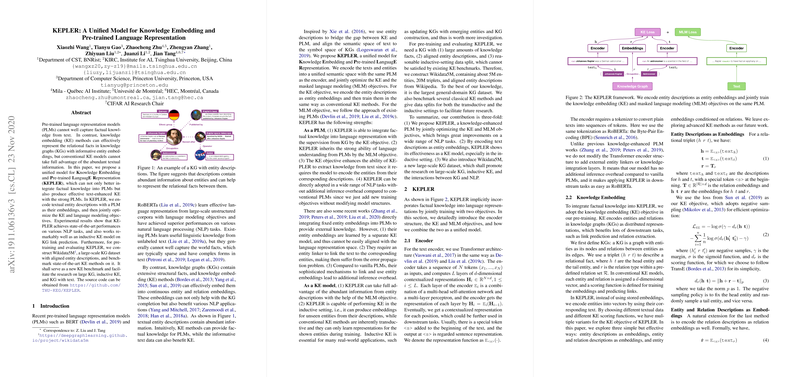KEPLER: A Unified Model for Knowledge Embedding and Pre-trained Language Representation
The paper presents KEPLER, a unified model that integrates knowledge embedding (KE) and pre-trained LLMs (PLMs) to enhance both language representation and factual knowledge retrieval. This approach addresses the limitations inherent in PLMs, such as BERT and RoBERTa, which, while effective for linguistic tasks, do not capture factual knowledge effectively. Conversely, KE models efficiently represent relational facts from knowledge graphs (KGs) but cannot leverage the rich textual information effectively.
Methodology
KEPLER bridges the gap between PLMs and KE by extending the capabilities of PLMs to include factual knowledge. The model accomplishes this by encoding entity descriptions from a KG as entities within the PLM itself, optimizing these embeddings alongside traditional LLMing tasks.
Specifically, KEPLER combines two key objectives in its framework:
- Knowledge Embedding (KE) Objective: This component uses entity descriptions from KGs to generate embeddings and employs a scoring function akin to TransE to train these embeddings effectively.
- Masked LLMing (MLM) Objective: Retaining this objective from traditional PLMs ensures that KEPLER's language representations remain robust and contextually aware.
KEPLER encodes entities and text into a unified semantic space using a Transformer model, maintaining the model structure of RoBERTa to avoid additional inference complexity.
Experimental Evaluation
KEPLER was evaluated on various NLP tasks and knowledge integration scenarios, demonstrating its ability to incorporate factual knowledge without compromising language understanding capability.
- NLP Tasks: KEPLER achieved state-of-the-art results across several challenging datasets such as TACRED for relation classification, FewRel for few-shot learning, and OpenEntity for entity typing.
- Knowledge Embedding Tasks: On tasks such as link prediction in knowledge graphs, KEPLER showed enhanced capability, especially in an inductive setting where unseen entities are involved.
The paper also introduces Wikidata5M, a large-scale knowledge graph dataset aligned with entity descriptions to serve as a comprehensive benchmark for testing such models.
Results and Implications
KEPLER’s performance indicates that joint optimization of KE and MLM objectives can enhance a PLM’s ability to recall factual knowledge while maintaining linguistic robustness. The integration of KE with PLMs opens up new possibilities for building models that efficiently leverage both structured and unstructured data.
Future Directions
The suggested future work includes:
- Exploring more sophisticated KE methods to enhance KEPLER's knowledge representation capabilities without increasing complexity.
- Developing better knowledge probing methodologies to accurately assess the model's knowledge retention and retrieval capabilities across diverse factual datasets.
In summary, KEPLER represents a significant step forward in the integration of linguistic and factual knowledge, providing a robust framework for applications requiring nuanced understanding from textual and structured data sources.
